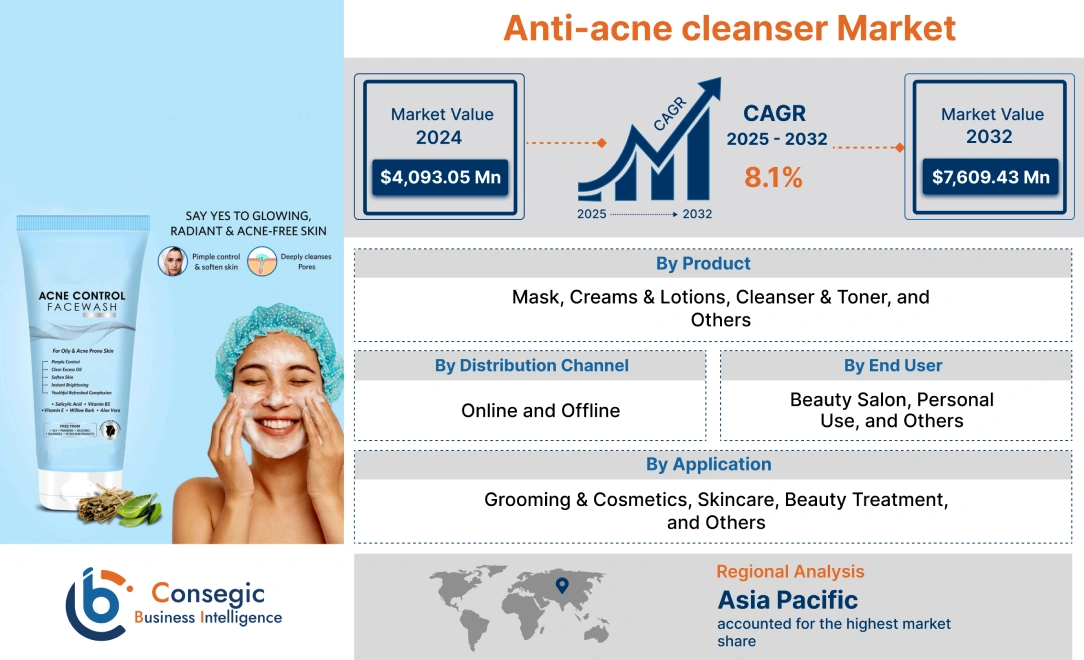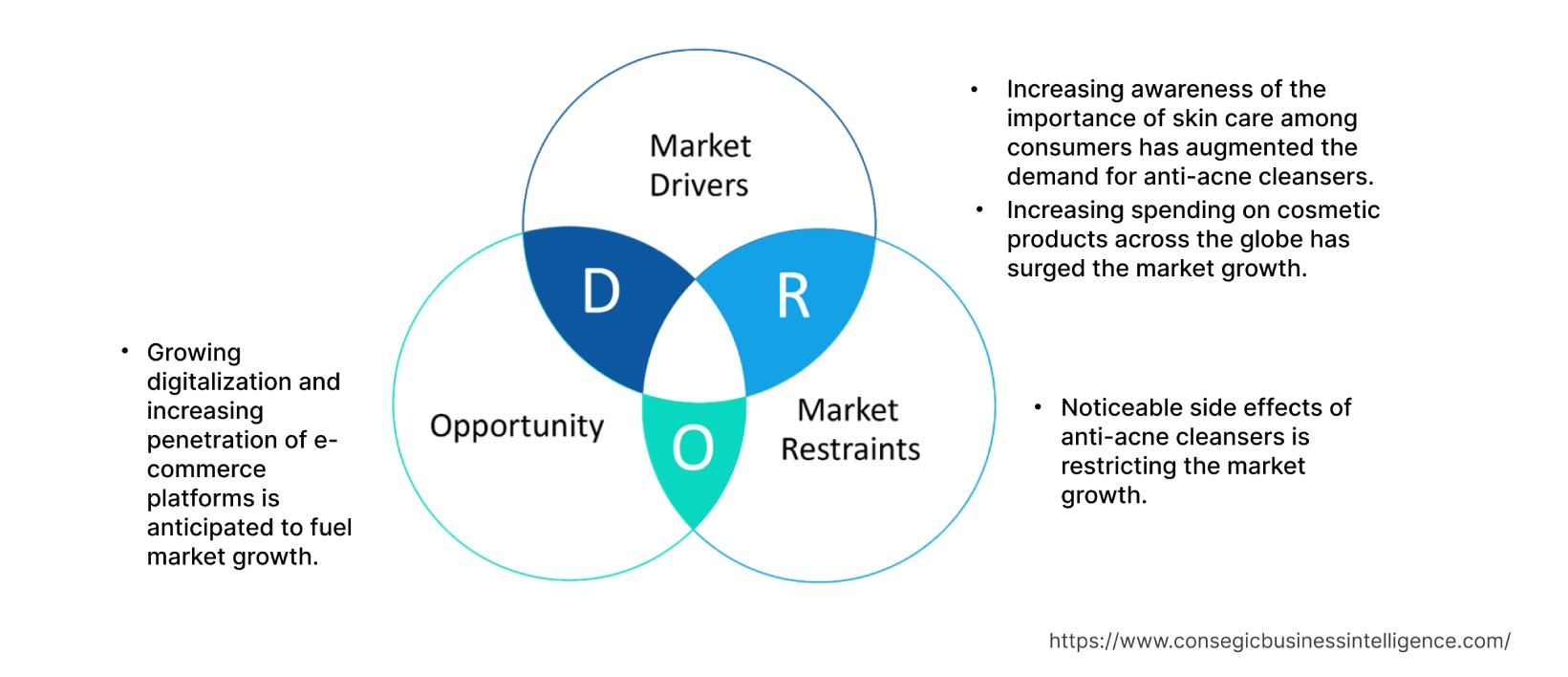- Summary
- Table Of Content
- Methodology
Anti-acne cleanser Market Introduction :
Consegic Business Intelligence analyzes that the Anti-acne cleanser Market size is estimated to reach over USD 7,609.43 Million by 2032 from a value of USD 4,093.05 Million in 2024 and is projected to grow by USD 4,350.02 Million in 2025, growing at a CAGR of 8.10% from 2025 to 2032.
Anti-acne cleanser Market Definition & Overview:
An anti-acne cleanser is a facial cleanser that contains ingredients that help to prevent and treat acne. Acne is a very common skin disorder that highly affects the skin's oil follicles and glands. This is a skin problem widely prevalent in both men and women due to high pollution, dust, and other factors. These cleaners are used to treat chronic skin disorders which cause spots and pimples on the neck, back, face, and shoulders. Acne problems can bring emotional distress, anxiety, and depression among consumers, and thus anti-acne cleansers play a significant role in mitigating such problems. Growing skin concerns and increasing spending on cosmetic products serve as growth factors for the market. In addition, increasing product innovation in acne cleansers by the key players operating in the market has been driving major growth opportunities for the product globally.
Anti-acne cleanser Market Insights :
Key Drivers :
Increasing awareness of the importance of skin care among consumers has augmented the demand for anti-acne cleansers
The rising awareness of the importance of skin care among consumers is driving the market growth of anti-acne cleansers. Increasing awareness regarding preservation of healthy skin, reduction of skin disorders, and enhancement of the appearance of the skin, serves as driving factors for the anti-acne cleaner market. Moreover, the rising beauty and dermatological treatment centers globally is acting as a catalyst for the growth of anti-acne cleanser market. Hence, due to the aforementioned factors, the increase in dermatological centres due to rising awareness of the importance of skin care has been driving the market growth of anti-acne cleansers.
Increasing spending on cosmetic products across the globe has surged the market growth
Rising consumer spending on cosmetic and beauty products is driving the growth of the anti-acne cleanser market. Increasing consumer spending has been attributed to people spending more on cosmetics products due to an increase in disposable income and an increase in appearance consciousness, which is driving the market growth of anti-acne cleansers. Moreover, an upsurge in the e-commerce industry coupled with rising purchasing power is acting as a catalyst for the growth of the anti-acne cleanser market. For instance, according to Invest India, the growing middle class population and rising disposable income are the key growth drivers for segments such as premium beauty and personal care products which is expected to grow at a CAGR of 54% from FY21-26. Thus, rising consumer spending on cosmetic products impacts the growth of anti-acne cleanser market.
Key Restraints :
Noticeable side effects of anti-acne cleansers is restricting the market growth.
There are several side effects of anti-acne cleaners based on skin type such as burning, dry and reddened skin, itching, peeling, and skin rash. These side effects prove to be harmful for consumers and the consumer needs to consult a dermatologist on an immediate basis. These allergic reactions to the product prove to be a restraint for the growth of anti-acne cleanser market. For instance, according to an article by the National Institutes of Health, the major side effects of skin cleansing agents are dryness and irritation of the skin. The article also mentions a substitute for anti-acne cleanser such as a non-ionic, fragrance-free dermatologic bar or liquid cleanser should be preferred over anti-acne cleansers. Hence, rising concerns about the side effects of these cleansers prove to be a restraint to the market growth.
Future Opportunities :
Growing digitalization and increasing penetration of e-commerce platforms is anticipated to fuel market growth
Rising number of e-commerce platforms selling their products, coupled with rapid urbanization and rising internet penetration, is estimated to drive major demand for anti-acne cleanser products among the target consumers, especially in the developing economies. For instance, according to a recent report by India Brand Equity Foundation, India had around 125 million online customer base from the year 2019 to 2022. It is expected that there will be around 80 million more customers by the end of 2025. Thus, increasing online sales, rising from growing digitalization, would directly influence more sales of anti-acne cleanser products through the online channel.
Anti-acne cleanser Market Report Insights :
| Report Attributes | Report Details |
| Study Timeline | 2019-2032 |
| Market Size in 2032 | USD 7,609.43 Million |
| CAGR (2025-2032) | 8.1% |
| By Product | Mask, Creams & Lotions, Cleanser & Toner, and Others |
| By Application | Grooming & Cosmetics, Skincare, Beauty Treatment, and Others |
| By End User | Beauty Salon, Personal Use, and Others |
| By Distribution Channel | Online and Offline |
| By Region | North America, Europe, Asia-Pacific, Latin America, and Middle East & Africa |
| Key Players | Crown Therapeutics, Unilever, Codex Labs Corp., L'Oreal Paris, DoctorLiLab, Vichy Laboratories, Sephora USA, Inc., Taro Pharmaceuticals USA Inc., Clinique Laboratories, llc., Johnson & Johnson Consumers Inc. |
Anti-acne cleanser Market Segmental Analysis :
Based on the Product :
The product segment is categorized into mask, creams & lotions, cleanser & toner, and others. In 2024, the creams & lotions segment accounted for the highest market share and is expected to grow at the fastest CAGR in the overall anti-acne cleanser market. The creams & lotions segment is growing due to rising demand for moisturizing creams and body lotions, as it protects the skin from skin infections and any bacteria formation. These creams mostly contain active pharmaceutical ingredients, antibiotics, and vitamins. Due to these creams being available in medicated form, the product has a significant demand from consumers. These creams & lotions are largely useful in unclogging the pores of the skin and reducing inflammation. Hence, due to the aforesaid advantages of the products, the creams & lotions segment is foreseeing significant growth in the anti-acne cleanser market.
Based on the Application :
The application segment is categorized into grooming & cosmetics, skincare, beauty treatment, and others. In 2024, skincare segment accounted for the highest market share of 39.35% and is expected to grow at the fastest CAGR in the overall anti-acne cleanser market. The rising market inclination toward a healthier lifestyle and growing awareness regarding skincare is imposing great opportunities for anti-acne cleaner product manufacturers. The growing need for early skincare intervention to prevent the worsening of skin conditions at later stages acts as a driving factor for skincare segment. Acne is one of the skincare concerns, and thus the large prevalence of skincare and acne-related problems among adolescents is driving the segmental growth of skincare in anti-acne cleanser market. Also, increasing aggressive advertising and marketing strategies of skincare products by the key players act as major growth drivers for the skincare segment in anti-acne cleanser market. For instance, L'oreal uses different marketing channels to promote their products such as digital marketing, traditional advertising, and influencer marketing. L'oreal has been very effective in its wide product marketing campaigns and in expanding its reach at high numbers. Thus, marketing and promotional strategies by the key anti-acne cleanser product manufacturers are very effective in the segmental growth of skincare in the anti-acne cleanser market.
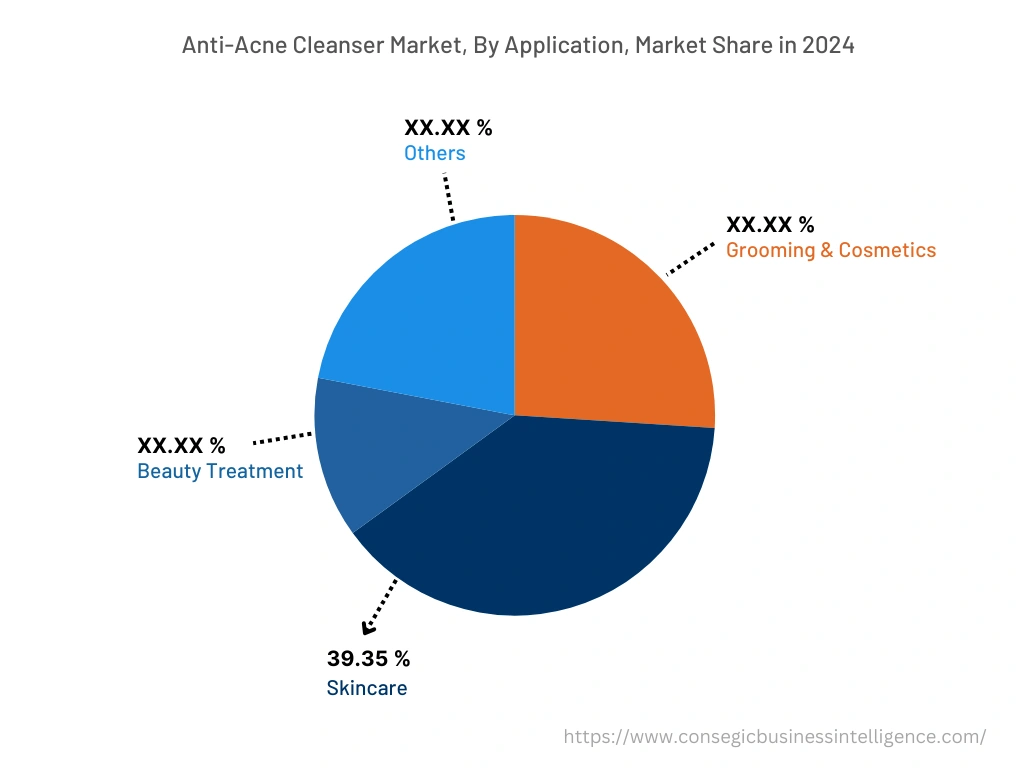
Based on the Distribution Channel :
The distribution channel segment is categorized into online and offline. In 2024, the offline segment accounted for the highest market share in the anti-acne cleanser market due to certain advantages such as better clarity of the product during on-spot purchase, tailored recommendations from dermatologist centers, and on-spot purchase benefits and discounts. Also, expansion in various offline retail chains across different regions globally by the cosmetic and beauty brands in the market is influencing significant growth in the offline segment.
However, the online segment is expected to grow at the fastest CAGR in the overall anti-acne cleanser market during the forecast period. Certain factors such as no additional costs incurred on warehousing, as the products can be shipped directly from the sellers. Also, other factors such as selecting the preferred delivery location, easy payment options, and wide shipping choices are influencing major demand for online channel. Additional offers and discounts, doorstep service, and convenience act as major catalysts for the growth of online distribution channel. Hence, due to the aforesaid factors, there is a major growth rate being foreseen for the online distribution channel in anti-acne cleanser market.
Based on the End-User :
The end user segment is categorized into beauty salon, personal use, and others. In 2024, beauty salon segment accounted for the highest market share and is expected to grow at the fastest CAGR in the overall anti-acne cleanser market. The anti-acne cleanser products are widely demanded in beauty salons due to the high rate of beauty care treatments and the increasing number of salons globally. These cleaners are widely used by beauticians in salons for treating acne and skin disorder consumers and it helps in removing dirt, oil, and dust from the skin without drying it out. Rising employment in the personal care sector is directly influencing the growth and expansion of beauty salons. For instance, according to the U.S. Bureau of Labor Statistics, the employment in personal care sector is projected to grow 14 percent from 2021 to 2031, which denotes a significant growth in the personal care and cosmetics sector. Hence, due to rising employment, arising from the expansion and growth of beauty salons, the beauty salon segment is foreseeing significant growth in the overall anti-acne cleanser market.
Based on the Region :
The regional segment includes North America, Europe, Asia Pacific, Middle East and Africa, and Latin America.
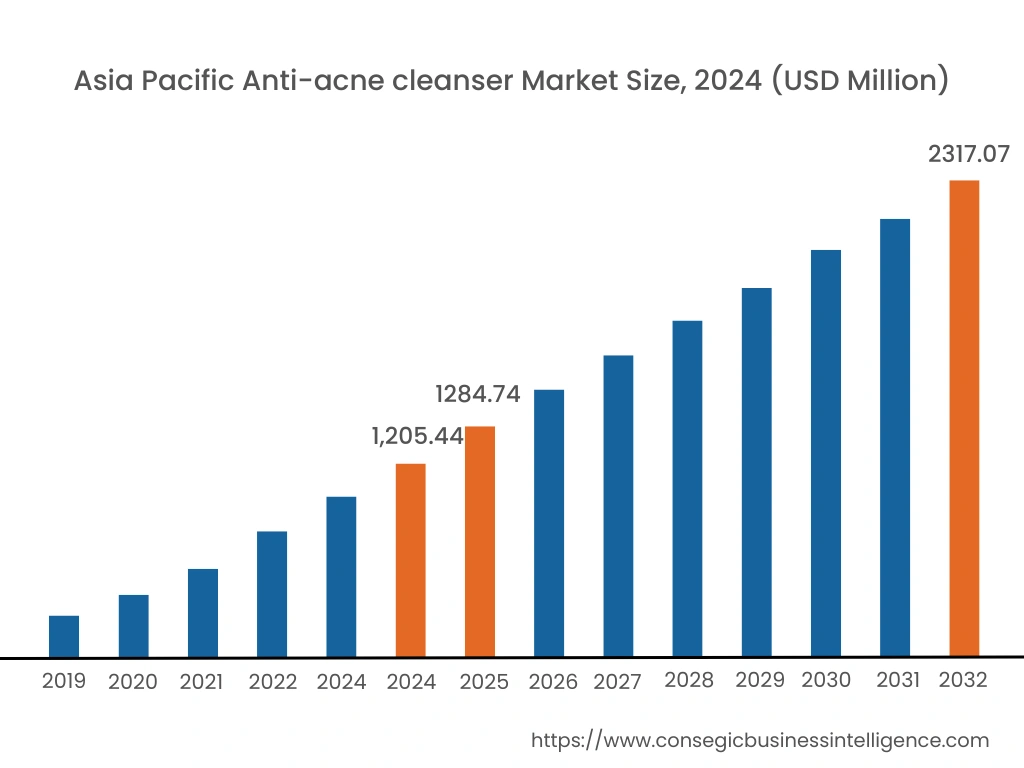
Asia Pacific region was valued at USD 1,205.44 Million in 2024. Moreover, it is projected to grow by USD 1,284.74 Million in 2025 and reach over USD 2,317.07 Million by 2032. In the Asia Pacific region, China accounted for the highest market share of 25.15% during the base year 2024. The increasing sale of beauty & personal care products and the high focus on the manufacturing of functional cosmetics and cosmeceuticals products are the factors driving the market growth across the region. For instance, according to the report by Euromonitor International in June 2022, sales of beauty and personal care in China reached USD 88 billion in 2021, a rise of 10% from the previous year. In addition, the increasing imports of skincare cosmetics are also driving market growth across the Asia Pacific region. For instance, in 2021, according to the Korea Customs Service statistics, skincare cosmetics continued to be the largest import category in the year 2020 representing 34.17%, or USD 560 million of total cosmetic imports. Hence, such high growth in the consumption and imports of skincare cosmetics and personal care products in the Asia Pacific region is driving the demand for anti-acne cleanser products in this region.
However, North America is expected to grow at the fastest CAGR of 8.8% during the forecast period due to the growing demand for functional skin care products across the region. The increasing problem of acne across the region is driving the demand for functional skincare products and benefiting the growth of anti-acne cleaner products. For instance, according to the data published by the American Academy of Dermatology, acne is the most common skin condition in the U.S., affecting up to 50 million population annually, approximately 85% of people between the ages of 12 and 24 experience at least minor acne in the U.S. Therefore, the aforementioned factors are anticipated to bolster the market growth in the North America region.
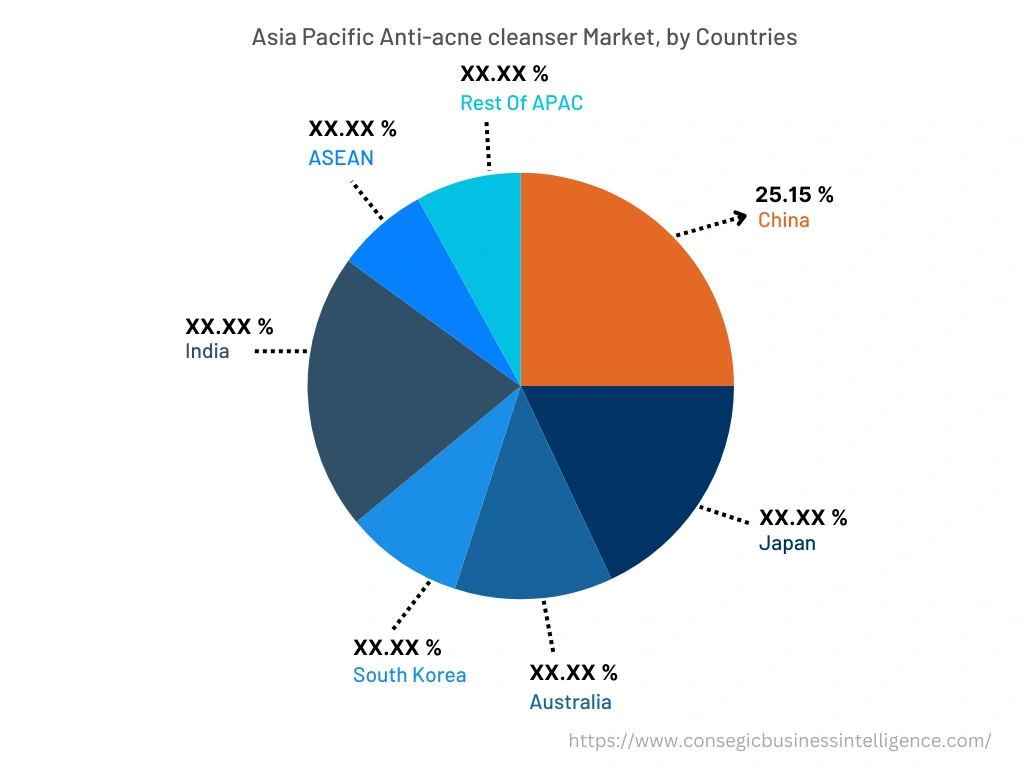
Top Key Players & Market Share Insights:
The anti-acne cleanser market is highly competitive, with several large players and numerous small and medium-sized enterprises. These companies have strong research and development capabilities and a strong presence in the market through their extensive product portfolios and distribution networks. The market is characterized by intense competition, with companies focusing on expanding their product offerings and increasing their market share through mergers, acquisitions, and partnerships. The key players in the market include-
- Crown Therapeutics
- Unilever
- Taro Pharmaceuticals USA Inc.
- Clinique Laboratories, llc.
- Johnson & Johnson Consumers Inc.
- Codex Labs Corp.
- L'Oreal Paris
- DoctorLiLab
- Vichy Laboratories
- Sephora USA, Inc.
Recent Industry Developments :
- In May 2023, Crown Therapeutics, a subsidiary of Crown Laboratories, announced the launch of PanOxyl, which is an Oil Control Moisturizer. As per the company, this new product is useful for treating acne and controlling oil production on the skin.
- In October 2022, Unilever, Plc., launched its new skincare brand Acne Squad. This new brand has a wide range of products specially designed for acne treatment. The product portfolio of the company contains products such as cleansers, moisturizers, toners, serums, spot correctors, scrubs, and peeling tonics.
Key Questions Answered in the Report
What was the market size of the anti-acne cleanser market in 2024? +
In 2024, the market size of anti-acne cleanser market was USD 4,093.05 million
What will be the potential market valuation for the anti-acne cleanser market by 2032? +
In 2032, the market size of anti-acne cleanser market will be expected to reach USD 7,609.43 million.
What are the key factors driving the growth of the anti-acne cleanser market? +
Increasing awareness of the importance of skin care among consumers is the key factor driving the growth of the anti-acne cleanser market.
What is the dominating segment in the anti-acne cleanser market by application? +
In 2024, the skincare segment accounted for the highest market share of 39.35% in the overall anti-acne cleanser market.
Based on current market trends and future predictions, which geographical region will have the fastest impact on the anti-acne cleanser market's growth in the coming years? +
North America is expected to be the fastest-growing region in the market during the forecast period.
